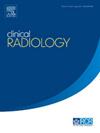Utilising preoperative pericoronary adipose tissue radiomics to predict improvements in European heart rhythm association symptom scores postatrial fibrillation ablation
IF 1.9
3区 医学
Q2 RADIOLOGY, NUCLEAR MEDICINE & MEDICAL IMAGING
引用次数: 0
Abstract
AIM
Atrial fibrillation (AF) recurrence after catheter ablation is clinically challenging; the predictive potential of pericoronary adipose tissue (PCAT) radiomics for symptom improvement remains underexplored. We developed a PCAT radiomics model utilising preablation cardiac computed tomography angiography (CTA) to predict symptom improvement among patients with postoperative AF recurrence.
MATERIALS AND METHODS
We included 146 patients who experienced AF recurrence after their first radiofrequency ablation procedure. Patients were divided into improvement (n=48) and nonimprovement (n=98) groups based on preoperative and postoperative European Heart Rhythm Association (EHRA) symptom scores, and into training (n=103) and validation (n=43) cohorts (7:3 ratio). In total, 5,064 PCAT radiomics features were automatically extracted from cardiac CTA images taken within 3 days preoperatively. Feature selection (logistic regression analysis, maximum-correlation minimum-redundancy, and genetic algorithms) and classification (logistic regression [LR], random forest [RF], and support vector machine [SVM]) methods were employed to construct the PCAT radiomics predictive model. Its predictive performance was evaluated using receiver operating characteristic curves, calibration, and decision curve analysis (DCA).
RESULTS
Five PCAT radiomics features were associated with EHRA symptom score improvement. The area under the curve (AUC) values of the LR, RF, and SVM models were 0.637, 0.858, and 0.756 in the training cohort, and 0.680, 0.812, and 0.751 in the validation cohort, respectively. The RF model had the highest AUC values. Calibration and DCA indicated good clinical efficacy of the radiomics model.
CONCLUSION
The RF model based on preoperative PCAT radiomics features predicts EHRA symptom score improvement in patients with postablation AF recurrence.
利用术前冠状动脉周围脂肪组织放射组学预测房颤消融后欧洲心律相关症状评分的改善
导管消融后房颤(AF)复发在临床上具有挑战性;冠状动脉周围脂肪组织(PCAT)放射组学对症状改善的预测潜力仍未得到充分探索。我们开发了一种PCAT放射组学模型,利用消融前心脏计算机断层血管造影(CTA)预测AF术后复发患者的症状改善。材料和方法我们纳入了146例首次射频消融术后房颤复发的患者。根据术前和术后欧洲心律协会(EHRA)症状评分将患者分为改善组(n=48)和非改善组(n=98),并分为训练组(n=103)和验证组(n=43)(比例为7:3)。总的来说,从术前3天内拍摄的心脏CTA图像中自动提取了5064个PCAT放射组学特征。采用特征选择(逻辑回归分析、最大相关最小冗余和遗传算法)和分类(逻辑回归[LR]、随机森林[RF]和支持向量机[SVM])方法构建PCAT放射组学预测模型。使用受试者工作特征曲线、校准和决策曲线分析(DCA)评估其预测性能。结果5项PCAT放射组学特征与EHRA症状评分改善相关。训练组LR、RF和SVM模型的曲线下面积(AUC)分别为0.637、0.858和0.756,验证组LR、RF和SVM模型的曲线下面积(AUC)分别为0.680、0.812和0.751。RF模型的AUC值最高。校正和DCA表明放射组学模型具有良好的临床疗效。结论基于术前PCAT放射组学特征的射频模型预测消融后房颤复发患者EHRA症状评分改善。
本文章由计算机程序翻译,如有差异,请以英文原文为准。
求助全文
约1分钟内获得全文
求助全文
来源期刊

Clinical radiology
医学-核医学
CiteScore
4.70
自引率
3.80%
发文量
528
审稿时长
76 days
期刊介绍:
Clinical Radiology is published by Elsevier on behalf of The Royal College of Radiologists. Clinical Radiology is an International Journal bringing you original research, editorials and review articles on all aspects of diagnostic imaging, including:
• Computed tomography
• Magnetic resonance imaging
• Ultrasonography
• Digital radiology
• Interventional radiology
• Radiography
• Nuclear medicine
Papers on radiological protection, quality assurance, audit in radiology and matters relating to radiological training and education are also included. In addition, each issue contains correspondence, book reviews and notices of forthcoming events.
 求助内容:
求助内容: 应助结果提醒方式:
应助结果提醒方式:


